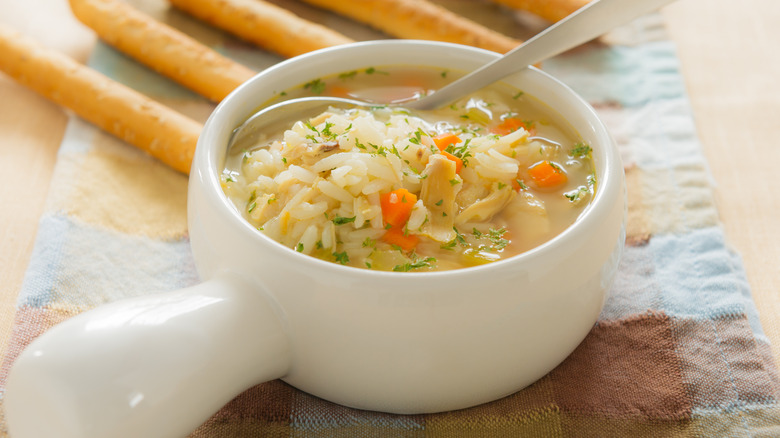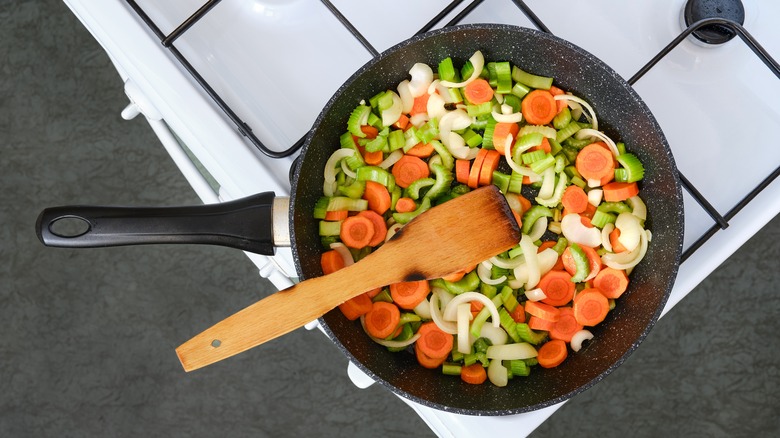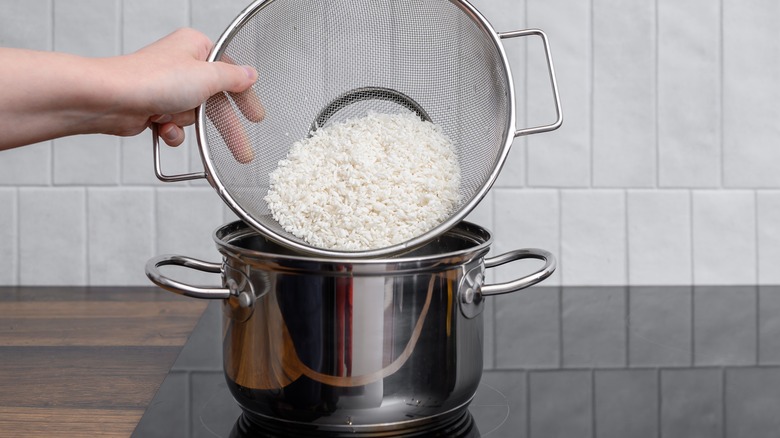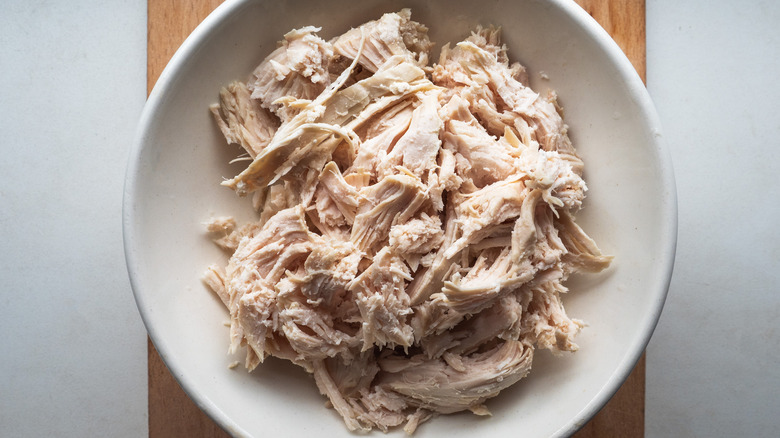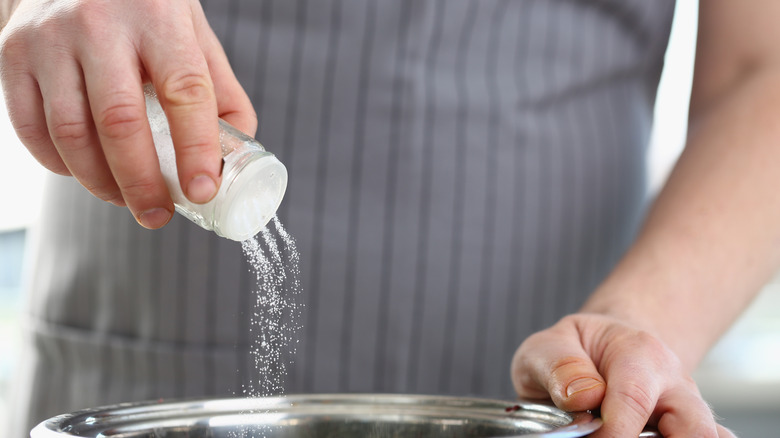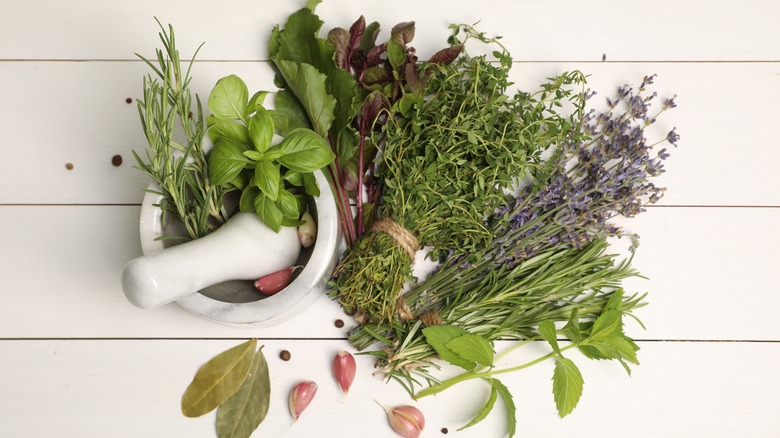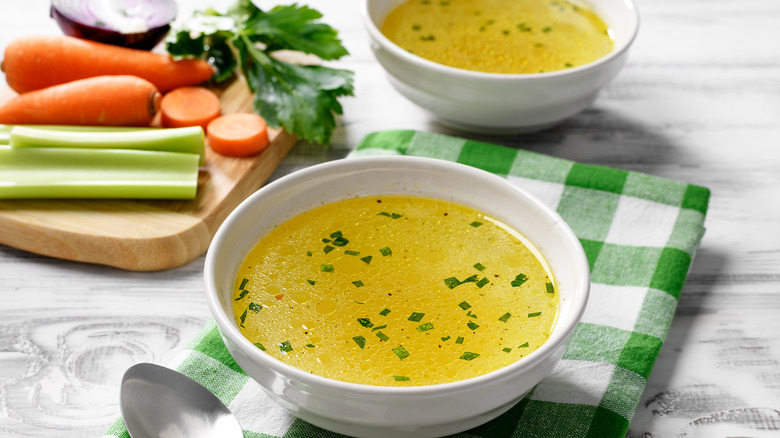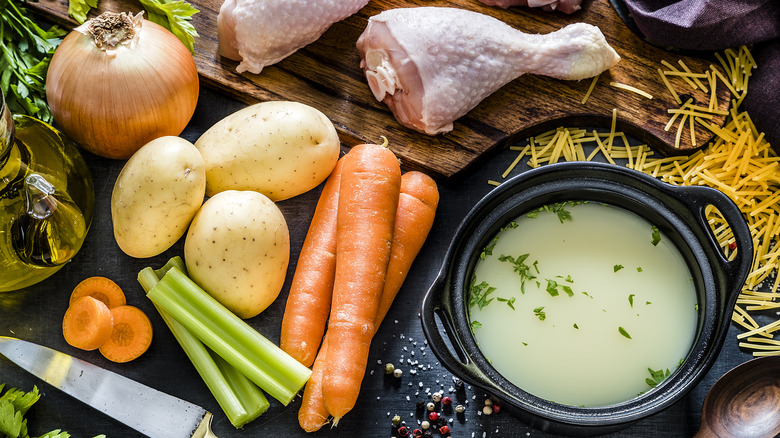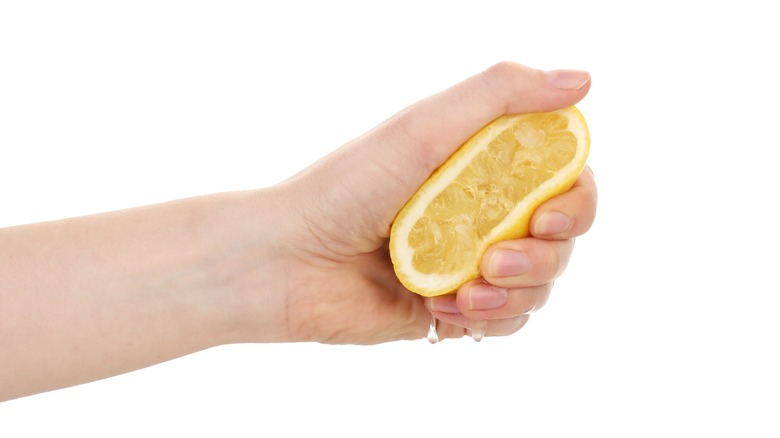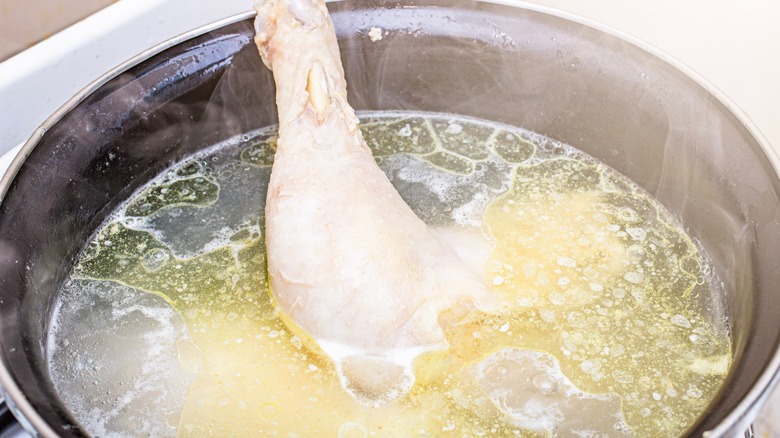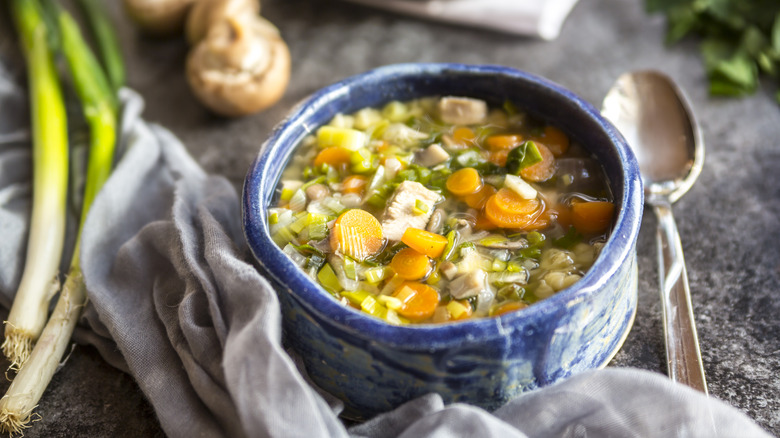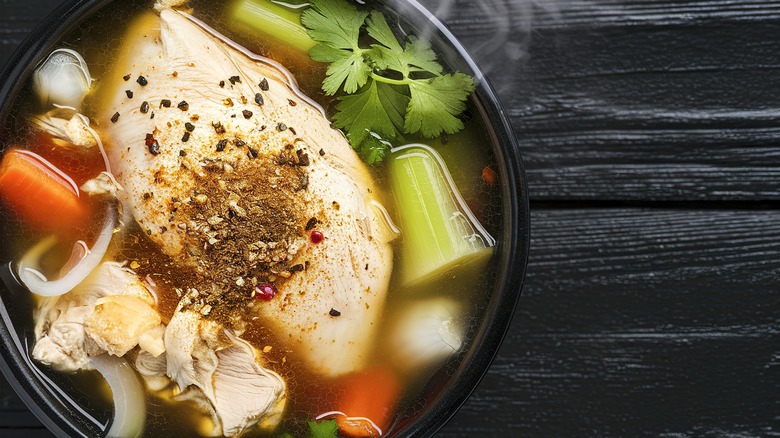13 Common Mistakes Home Cooks Make With Chicken And Rice Soup
Let's face it: Making chicken and rice soup isn't supposed to be all that difficult. You throw everything in a pot and cook, right? Well, kind of. Sure, you'll get something edible if you do it that way; it's one of the most comforting soup recipes out there, after all. Still, if you want to make a chicken and rice soup that a pro cook would be proud to serve, it takes a whole lot more than simply adding ingredients and letting it ride. In fact, there's a whole slew of common mistakes you need to avoid. Um, what? Yeah, but once you get your recipe just right, you'll never look back.
I consulted an expert, Jessica Randhawa, to determine the common mistakes we all need to avoid when crafting a batch of chicken and rice soup. She's the owner and head chef at The Forked Spoon, a site full of delicious recipes for family-friendly meals, several of which are versions of chicken and rice soup. Follow her lead, and your next homemade chicken and rice soup will be one to remember.
Using only chicken breast
For a lot of shoppers, chicken breasts are a go-to choice. While chicken breast meat is great for countless dishes, opting for only this cut in your chicken and rice soup is a mistake Jessica Randhawa said we'd be wise to avoid. According to her, "Chicken breast can get dry and bland if overcooked," and when it comes to making soup, this happens quicker than many of us would expect.
Instead of honing in on chicken breast alone, Randhawa revealed, "I like to use a mix of dark and white meat, or even bone-in cuts for extra flavor." Using various cuts leads to richer flavors and better textures down the road — and we all want that, right? Randhawa also revealed another tip to help us avoid overcooking the chicken, regardless of the cut, but we'll get to that later. For now, just know that a combination of white and dark meat is recommended if you want the best chicken and rice soup possible.
Not sautéing vegetables first
Simply tossing raw vegetables into your chicken and rice soup is the next mistake Jessica Randhawa said we should avoid. As she put it, "Raw veggies can taste flat in soup." Flat, eh? We can't have that. Instead, she mentioned you should, "Sauté your onions, carrots, and celery first to build deep, sweet flavor as a base." As your veggies cook, the flavors build and develop a more potent, caramelized taste. No surprises here, but when you add them to your soup, it'll really pay off in the flavor department.
Fortunately, onion, carrot, and celery are already a dynamic combination. The mix even has its own name: mirepoix. Ever heard of it? My guess is yes. If you don't already know, it's a game-changing base for countless sauces and soups. Get your mirepoix right, aka sauté it a bit before tossing it into your soup pot, and you can expect an instant flavor upgrade perfect for chicken and rice soup. Since mirepoix is so common, though, you'd be wise to take Randhawa's advice with you when you use it in other recipes.
Adding uncooked rice too early
Rice may be a staple food across the world, but it's a bit finicky. It has to be cooked just right. When undercooked, the grains don't soften properly. If rice is overcooked, it can also quickly turn to mush. With this in mind, attention to detail is key when adding rice to your chicken and rice soup. Our expert Jessica Randhawa agrees. She said, "Rice expands and can turn mushy if simmered too long." Okay, noted. So, how do we fix this?
Randhawa noted we have two options when it comes to achieving perfectly cooked rice in your chicken soup: "I usually add it halfway through cooking, or even cook it separately to keep the texture just right." If you trust your instincts, go ahead and aim for Randhawa's first tip, adding it halfway through. However, if you would rather play it safe, simply cooking your rice separately and adding it at the end is a no-brainer. It is basically foolproof, after all. Either way, your soup will be better off because of it.
Forgetting to rinse the rice
Speaking of rice, there's another common mistake Jessica Randhawa said we need to avoid when making soup — and this one happens before you start cooking it or adding it to your soup. What is it? Forgetting to rinse it first. As Randhawa said, "Starchy rice will cloud your broth." This may not have a huge effect on flavor, but it'll certainly look less appealing. Since we eat with our eyes, first, appearance matters. The best chicken and rice soups have a deliciously golden broth, so don't let yours turn cloudy.
Randhawa recommends prepping your rice by giving "it a good rinse until the water runs clear before adding it to your soup." That way, all the potential cloudiness simply washes down the drain. Easy peasy. Take your time here, too. It may seem simple, but small details like this make all the difference in the end. A good-looking soup catches the eye and brings people back for more. A bad-looking one is easy to overlook, and it might even result in uneaten leftovers.
Overcooking the chicken
Circling back to chicken, selecting the right pieces isn't the only thing you need to do to get your chicken and rice soup just right. No surprises here, but how long it is cooked plays a vital role in your soup's success as well. In fact, cooking it for too long would be a big mistake. Actually, come to think of it, undercooking is a massive fail, as well, but that's not nearly as common a blunder as overcooking it.
When making chicken and rice soup, Jessica Randhawa said, "It's tempting to throw everything in at once, but chicken is best when it's gently simmered and removed as soon as it's cooked through." Once you remove the cooked chicken, she recommends shredding it and only returning it to the pot at the very end. According to her, this ensures "the juiciest bites." There's no arguing with that. Who doesn't want the juiciest bites? Enough said.
Under seasoning, more specifically under-salting
Salt is an essential element in cooking, and this includes chicken and rice soup. Without it, food is unnecessarily bland, and it will never live up to restaurant standards. So, under-salting is a big mistake, and as it turns out, a lot of us make it. As our expert Jessica Randhawa said, "Chicken and rice soup needs more salt than you might expect, especially if using homemade or low-sodium broth." Actually, a healthy dose of salt is one of the reasons so many restaurant dishes taste better than homemade. Not any more, though, at least not in your kitchen.
When it comes to salting your next batch of chicken and rice soup, Randhawa recommends tasting and adjusting as you go. Translation: Start small, stir, and go slow. Then, taste, and repeat until you achieve the perfect level of saltiness. You can always add more salt, but making your chicken and rice soup less salty is way more complicated. Plus, you want to wait until the saltiness of chicken and maybe even your vegetables (if you salt them while sautéing) takes hold of your soup before going full throttle. However, since home cooks commonly under-salt their soup, it probably needs more than you think. Just taste as you go, and you will do great.
Not using enough aromatics
No chicken and rice soup is complete without aromatic herbs, and most recipes already call for ones like garlic and thyme. However, a common mistake home cooks make is not adding enough of them, especially if they are just winging the recipe (as many of us do). Just like salt, if you do not use a good amount of aromatics, your soup will likely fall flat in the flavor department. We can't have that.
Our expert Jessica Randhawa noted taht adding aromatics to chicken and rice soup is key and you should not be afraid to experiment: "Bay leaves, garlic, fresh thyme, or even a chunk of ginger can make all the difference." In one of her more creative chicken and rice soup recipes, she layers a collection of aromatics, including red pepper flakes, thyme, Italian seasoning, garlic, and lemon. She even tosses some white wine into the mix, so, yeah. Experimenting can serve you well.
If you want your aromatics to really pop with fresh flavor, there are a couple of things you can do. First, lightly bruise your herbs before adding them. This helps release more of the oils and flavor within. Simply smacking them on the palm of your hand should suffice. After that, make sure to keep some of them on the side so you can add them to the soup at the end.
Using store-bought broth without enhancements
Look, there is no shame in using store-bought broth for your chicken and rice soup. While homemade broth allows a lot more control, the store-bought stuff isn't bad. However, if you decide to go this route with your chicken and rice soup, our expert says choosing to forgo a couple of enhancements is a mistake you don't want to make. According to Jessica Randhawa, "A splash of white wine, a parmesan rind, or extra herbs will even elevate boxed broth," not just homemade.
As it turns out, there are many ways to improve the flavor of store-bought broth so it tastes more homemade. In addition to the enhancements Randhawa mentioned, you can also add umami flavor with things like garlic or mushrooms. More aromatic herbs, which we discussed above, also lend a serious helping hand to store-bought broth. If these aren't an option, you can also simmer your broth until it reduces a bit before moving forward with your chicken and rice soup. This helps concentrate the flavors within, something that is often quite subtle in pre-made stocks. Whatever you choose to do, enhancing store-bought broth is a must.
Adding all of the ingredients at once
We've already discussed the importance of timing when it comes to rice and chicken for soup. However, to further cement the idea into our heads Jessica Randhawa said another common mistake is simply tossing all of your chicken and rice soup ingredients into the pot in one fell swoop. Actually, this is one of the common blunders everyone makes with chicken noodle soup as well, so you may want to file this tip away for any kind of soup you make in the future.
Most home cooks already know this on some level, but Randhawa wanted to make sure, so she said, "Rice, chicken, and vegetables all cook at different speeds." To avoid over or under-cooking ingredients and ensure everything comes out just right, she added that staggering their addition is the way to go. Plus, we already know that adding uncooked rice too soon is a fatal error, so just apply this idea to all of the ingredients you use, and you should be good to go.
Skipping the acid
There are four essential flavor profiles in cooking: salt, fat, acid, and heat. When you get them perfectly balanced, whatever you make tastes infinitely better, and this includes chicken and rice soup. We already talked about salt, and now it's time for acid. According to Jessica Randhawa, skipping it is a common mistake you want to avoid.
Fortunately, skipping the acid component in your chicken and rice soup is one of the mistakes that's easy to skirt. Randhawa explained, "A squeeze of lemon juice or a splash of vinegar at the end wakes up all the flavors and balances the richness." It may sound so simple that it wouldn't make much of a difference, but adding either lemon juice or white vinegar brightens flavors throughout in a way nothing else can. As noted, it also balances the essential flavor profiles. When one is out of whack, they all pay. Do not let this happen to your soup.
Not skimming the fat
Fat and chicken go hand in hand; there's really no getting around it. With this in mind, it's easy for chicken and rice soup to develop a layer of fat on the surface. While this could potentially add flavor (it's fat, after all), Jessica Randhawa said not skimming excess fat off of your soup is a mistake.
While removing extra fat on the surface of your chicken and rice soup will always serve you well, Randhawa noted that it is particularly important when using skin-on chicken. It has a higher fat content than leaner cuts with all the fat removed. Regardless, skimming the fat off the surface of your soup leads to "a cleaner, lighter-tasting soup," said Randhawa. It makes sense, too. Leaving it will give your soup a greasy taste and feel. It will also obscure your beautifully crafted golden broth below, so there's an aesthetic benefit as well. To avoid all this, simply use a ladle to get rid of it. Problem solved.
Playing it too safe with the ingredients
The most basic of chicken and rice soups contains mirepoix (diced onion, carrot, and celery), chicken, rice, broth, and seasonings. However, that's not where the fun stops, or at least it shouldn't. The basic ingredients also pair well with lots of creative twists. So, choosing to always play it safe is a mistake you don't want to make.
According to Jessica Randhawa, you should, "try adding leafy greens, artichoke hearts, wild rice, or even a handful of fresh herbs at the end. It's hard to go wrong!" She also uses zucchini in one of her creative chicken and rice soup recipes. Some other notable veggie mentions include corn, peas, leeks, potatoes, and mushrooms, but whatever you have in the fridge will likely work. If you really want to do something different, though, you can always turn it into a Hispanic-style tortilla soup or add green or red curry. Truly, the sky is the limit with this comforting soup. When you veer away from the typical, the flavor only gets better.
Overcrowding the pot
The final mistake people fall prey to when making chicken and rice soup is overcrowding the pot. Here's the thing, too: Even if you are following a recipe, if your pot isn't big enough, it can still go badly. So really, this is a super easy blunder to commit. Even so, this is one of those cases where less can be more.
According to Jessica Randhawa, "Too many veggies, too much rice, or too much chicken can make the soup muddy and thick." No, thanks. Instead, the ingredients need to be balanced and, most importantly, be able to fit into your pot without overcrowding it. In addition to the reasons Randhawa mentioned, overcrowding your pot can lead to longer cooking times, so it's a lose-lose.
If you notice your pot is starting to become overcrowded or the ingredients are unbalanced, you have two options. The first is to transfer it to a larger pot. The other is to add more broth or stock, but this only works if your pot has extra space and you're trying to thin out the veggies, rice, and chicken a bit. If you go the second route and add more broth, make sure to adjust your seasonings, as well. Other than that, if you avoid all of the common mistakes Randhawa revealed, you should be well on your way to making drool-worthy chicken and rice soup. Yum.

